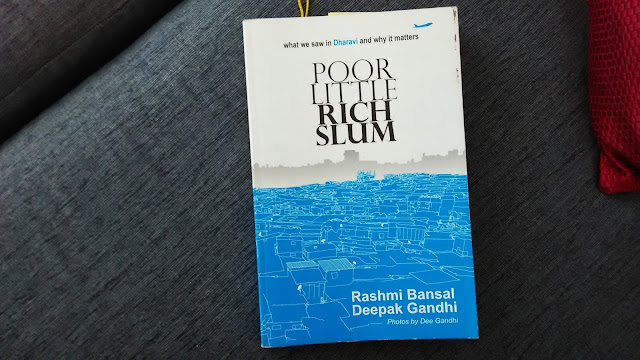Poor Little Rich Slum is a book I picked up out of curiosity. I had enough about Dharavi and redevelopment projects. I just wanted to see another perspective to it. I did not learn something new out of the book, but I definitely came across a fine writing. The book is a piece of art with an amazing collection of photos and beautiful presentation.
We wish they would not exist, but we cannot wish them away. Sixty percent of our city is a slum and it all started here, in Dharavi.
Cover page
The cover page is an aerial sketch of the slum with a gray skyline and white sky. The tile is on the top above which is the tagline which says “what we saw in Dharavi and why it matters”. The cover behind is similar. It has the title and a message behind. I am really impressed by the cover page.
Characters
The book is a non-fiction where the authors go around Dharavi meeting different people and understanding the structure head to toe. The book features the stories of different entrepreneurs of Dharavi, people who are helping it develop and few others. The characters are the people whom you may find in your everyday life. The writing is what makes them sound like superman!
Content
The outsider is blind to the drudgery of Dharavi. He chooses to see a colorful, chaotic, creatively inspirational mess. We watch these blind men as they scramble over the elephant of Dharavi. It is an amusing sight and, at the same time, a tragic one.
Above are few sentences that are written by the authors about the situation in Dharavi. They have picked up individual entrepreneur stories from the slum. The book showcases how the inhabitants have made a comfortable life for themselves despite the hardships.
There is also a mention of different NGOs working towards a better life for the people in Dharavi. The book gives a statistical account with a personal take on the lives. It is not always the pitying state. The authors also provide with solutions towards the end.
The content of the book is well put together. This is a massive positive point in the book.
But all’s fair in love, war and business.
Language
The language is very simple since the book is directed to the majority who cares about the cause. The authors also go poetic in a few places, quoting books. It also has a Hindi sentences to bring people in slums closer to the readers. I liked the flow of sentences. Even though they are separated by wide gaps the sentences seem to have a flow.
Good points
The cover page is an art. It gracefully portrays the non-fiction part and does not compromise on the reachability.
The content is well compiled. It has been presented well with the help of photographs and just a good graphic designing. The language is simple and connectable. Simple quotes here and there make the book all the more beautiful.
Bad points
Even though the book is a good read I did not find anything I did not know already. I was expecting more out of this book.
We don’t want to move somewhere else.
Overall
The book is a well-researched account of the lives in Dharavi, and the development programs.
Who do I recommend this to
I would recommend this book to someone who wants to understand the situation in Dharavi. It is a good read for someone who likes a well-presented book.
Quotable Quotes
There is a revolution in Dharavi. A revolution of energy and enterprise.
Yahan sab kuch hai—paisa accha hai, log acche hain, par aasmaan nahi hai, jaan hai, jahan nahi hai.
Now, here’s the ‘sample flat’. Each house measures 300 sq ft. This is the living room—velvet sofa, flat-screen TV and modern art on the wall. Come, see the modular kitchen, isn’t it nice? Here is your bedroom, with a built-in cupboard. Do you like the bedspread? Come, see your study room with computer (LCD monitor). Itna sab kuch 300 sq ft mein? This is a work of science fiction. The fiction of making promises. The science of never keeping them.
In Dharavi, an address is meaningless. Any place is only known by its proximity to another place.

